Key Findings
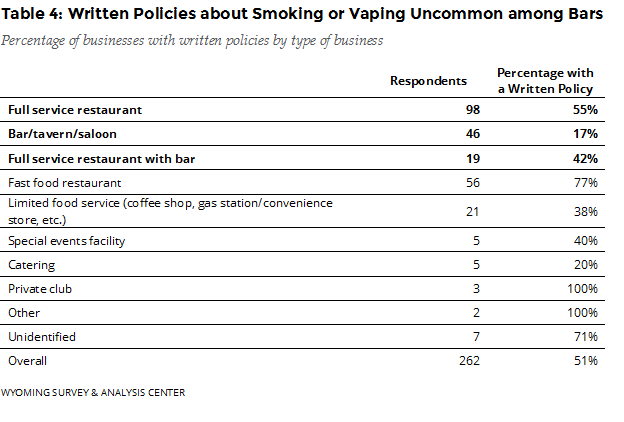 Dining Survey
Dining Survey
About half (51%) of Wyoming dining businesses (including bars) had a written policy about smoking or vaping, though the prevalence of these policies varied by business type (Table 4). These policies were most common among fast food restaurants, when excluding business types with five or fewer respondents. Full service restaurants were more likely to have a written policy than full service restaurants with attached bars. Bars, taverns, and saloons (as a single category) were the least likely dining business type to have written policies.
Smaller businesses (as measured by the number of employees) were less likely to have a written policy than larger businesses (Figure 2).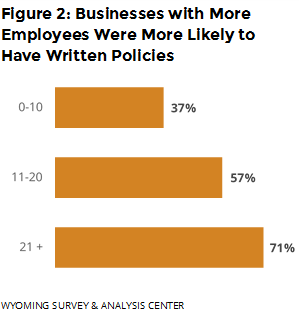 Policies specific to the respondents’ locations accounted for 29% of smoking and/or vaping policies, while parent company rules accounted for 7%. Multiple sources were indicated by 3% of respondents. Of those who indicated a smoking and/or vaping policy, 75% said their policies were written and visible to employees.
Policies specific to the respondents’ locations accounted for 29% of smoking and/or vaping policies, while parent company rules accounted for 7%. Multiple sources were indicated by 3% of respondents. Of those who indicated a smoking and/or vaping policy, 75% said their policies were written and visible to employees.
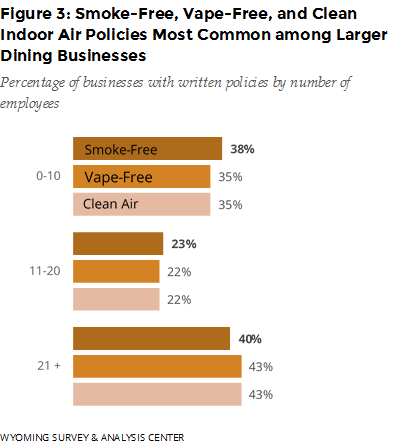
Larger businesses were more likely to have healthier air policies for their indoor dining areas, followed closely by small businesses. Mid-sized businesses were the least likely to have clean air policies (Figure 3). Most businesses had smoke-free indoor air policies, but fewer than half had vape-free or clean indoor air policies. Smoke-free, vape-free, and clean air policies were much less common for outdoor areas and uncommon for other outdoor areas (Figure 4). The absence of a vape-free policy was the limiting factor for businesses to qualify as having clean air policies. For each coverage area (indoors, outdoor dining area, and other outdoor areas), dining businesses rarely had vape-free policies in the absence of smoke-free policies.
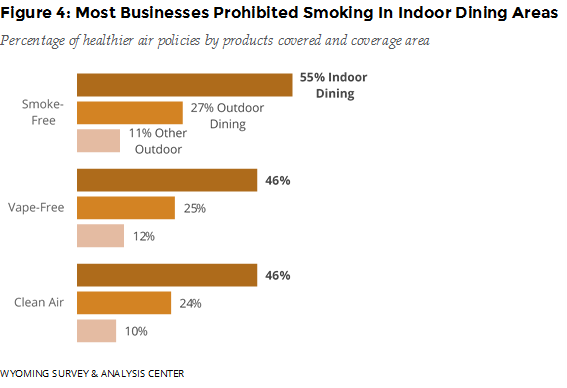
The prevalence of smoke-free, vape-free, and clean air policies varied by business type. Policies covering indoor dining areas, outdoor dining areas, and other outdoor areas were most common among fast food restaurants and businesses that did not identify their type (after excluding business types with five or fewer respondents). Customers and employees at bars were the least often covered by smoke-free, vape-free, and clean indoor air policies (Table 5). 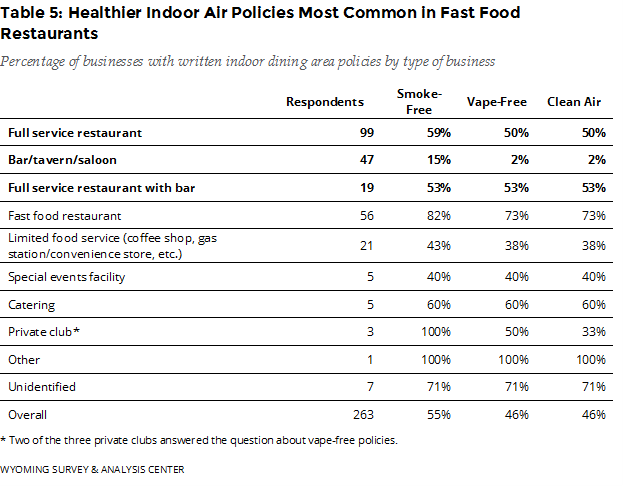
Fast food restaurants were also the most likely to have smoke-free, vape-free, and clean air policies covering their outdoor dining areas (after excluding business types with five or fewer respondents). Customers and employees at bars were the least often covered by smoke-free, vape-free, and clean indoor air policies (Table 6)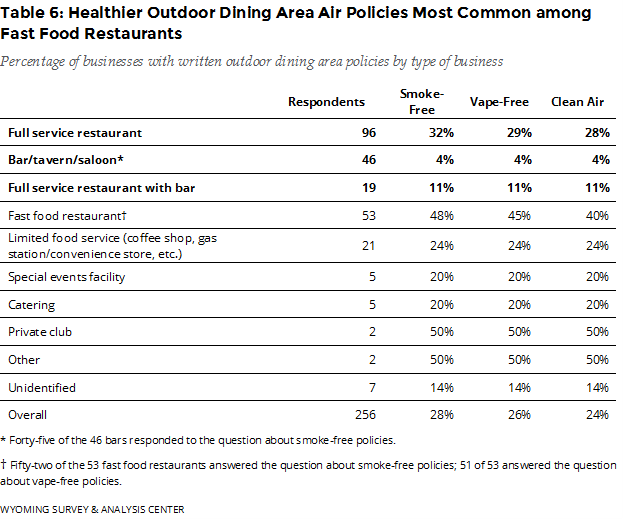 .
.
Fast food restaurants were also the most likely to have smoke-free, vape-free, and clean air policies covering their other outdoor areas (after excluding business types with five or fewer respondents). When focusing on full service restaurants without bars, bars, and full service restaurants with bars, customers and employees at limited service restaurants, bars, and businesses of unknown type were the least often covered by smoke-free, vape-free, and clean indoor air policies (Table 7).
Lodging Survey
Overall, 62% of lodging establishments had a written policy addressing smoking or vaping. The majority of tobacco policies (60%) in lodging establishments were local policies specific to the individual business location. Other sources for the policies included complying with local ordinances (17%; none of which prohibit smoking in all indoor guest areas), policies of a parent company (13%) and multiple sources (10%). Of the businesses with written policies about smoking or vaping, 83% said the written policy was posted and visible to employees. When looking across all areas, 52% of the respondents to the Lodging Survey were smoke-free in all indoor areas; 45% were vape-free across all indoor areas; and 43% had comprehensive clean indoor air policies.
Smoke-free, vape-free, and clean indoor air policies were most common for indoor common areas (e.g., lobbies) and employee-only areas. Allowing smoking or vaping in at least some guest rooms was a relatively common practice in Wyoming. As with the Dining Survey results, smoke-free policies were more common than vape-free indoor air policies. Few businesses had vape-free policies in the absence of smoke-free policies, making vape-free policies the limiting factor on having clean air policies (Figure 5).
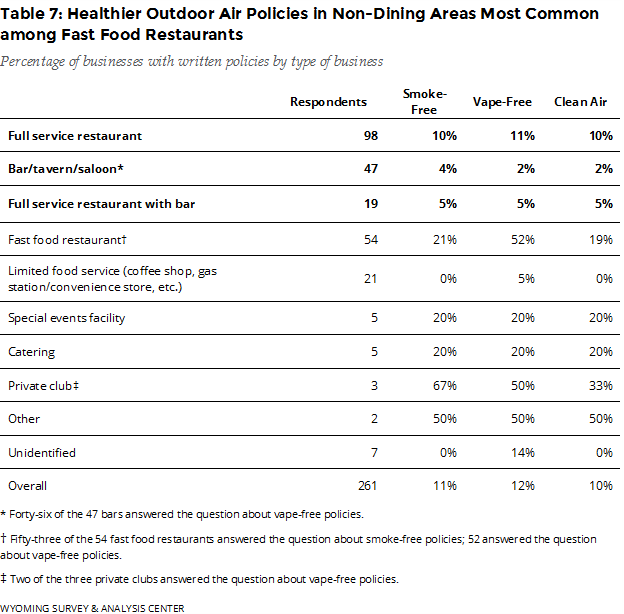
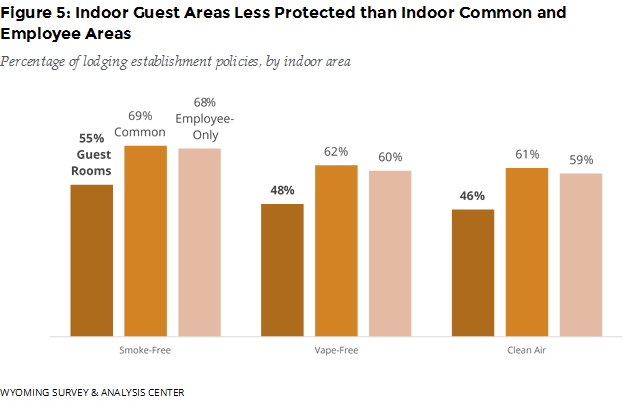
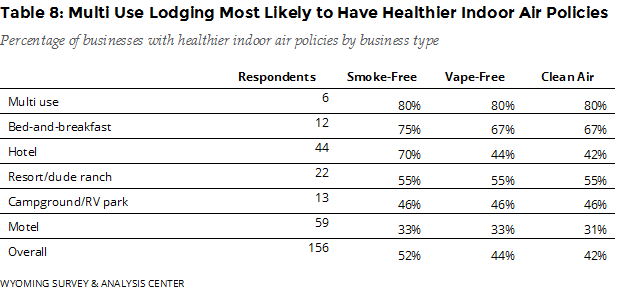 As with the Dining Survey, the prevalence of these policies differs across lodging business type. Each type of healthier indoor air policy was most common in multi-use businesses and bed-and-breakfast establishments, and 70% of hotels were smoke-free. Motels were the least likely to have any of these policies (Table 8).
As with the Dining Survey, the prevalence of these policies differs across lodging business type. Each type of healthier indoor air policy was most common in multi-use businesses and bed-and-breakfast establishments, and 70% of hotels were smoke-free. Motels were the least likely to have any of these policies (Table 8).
Outdoor smoke-free, vape-free, and clean air policies were uncommon. When they were in place, they were more likely to cover outdoor areas of guest rooms (e.g., balconies or patios; Figure 6).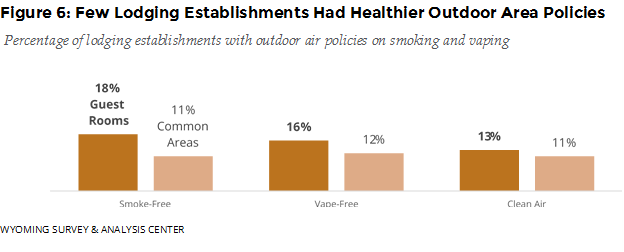
Because lodging establishments may offer their guests the convenience of an attached restaurant, which may or may not share indoor or outdoor air policies with the lodging business, it is important to examine how the policies of neighboring businesses relate to secondhand smoke exposure while at a lodging establishment. The majority of respondents (86%) reported they never smell smoke from neighboring businesses, while 11% said they “sometimes” smell smoke. No respondents stated that they “always” smell smoke.

